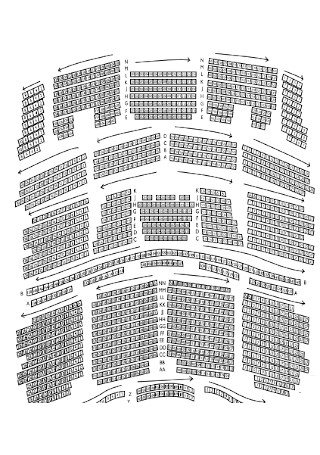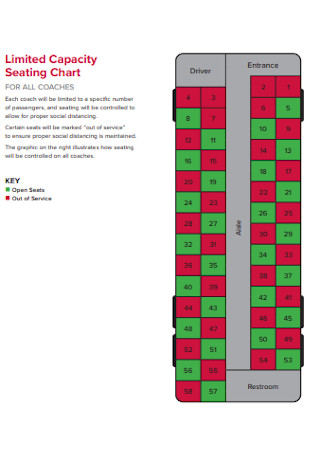50+ Sample Seating Charts
-

Theatre Seating Chart
download now -

Sample Seating Chart
download now -

Auditorium Seating Chart
download now -

Hall Seating Chart
download now -

Simple Seating Chart
download now -

Balcony Seating Chart
download now -

Music Theater Seating Chart
download now -

School Auditorium Seating Chart
download now -

School Bus Seating Chart
download now -

Theatre Center Seating Chart
download now -

Accessible Seating Chart
download now -

Orchestra Seating Chart
download now -

Primary Seating Chart
download now -

Hall Seating Plan Chart
download now -

Seating Chart Format
download now -

Standard Seating Chart
download now -

Theater Seating Number Chart
download now -

Stage Seating Chart
download now -

Auditorium Seating Chart Template
download now -

Online Test Seating Chart
download now -

Event Hall Seating Chart
download now -

Round Stage Seating Chart
download now -

House Seating Chart
download now -

University Seating Chart
download now -

Basketball Seating Chart
download now -

Orchestra Level Seating Chart
download now -

Theater Seating Chart Format
download now -

University Center Seating Chart
download now -

Performance Theater Seating Chart
download now -

Banquet seating chart
download now -

Bus Seating Chart
download now -

Indian Ranch Seating Chart
download now -

Printable Seating Chart
download now -

Special Needs Seating Chart
download now -

Theater Mainstage Seating Chart
download now -

Limited Capacity Seating Chart
download now -

Main Floor Seating Chart
download now -

Meeting Rooms Seating Chart
download now -

Family Playhouse Seating Chart
download now -

Anphitheater Seating Chart
download now -

Full Seating Chart Template
download now -

Stadium Seating Chart
download now -

Theater Seating Map Chart
download now -

House Representative Seating Chart
download now -

Auditorium Stage Seating Chart
download now -

Chamber Hall Seating Chart
download now -

Sample Stadium Seating Chart
download now -

Social Distancing Theater Chart
download now -

Sample Stadium Seating Chart
download now -

Seating Diagram Chart
download now
FREE Seating Chart s to Download
50+ Sample Seating Charts
What Is a Seating Chart?
The Importance of Seating Charts in Different Examples
What Are the Basic Parts of a Seating Chart?
How to Create a Proper Seating Chart
FAQs
What are the different types of seating arrangements?
What is the difference between seating arrangement and sitting arrangement?
Does seating affect communication?
What Is a Seating Chart?
A seating chart refers to the visual representation of where people can sit in a particular room, event, or situation. It can be used for simple cases like where your guests can sit for your birthday party or on a bigger scale where a seating plan is needed for a sports arena or concert. Expect the chart to have a board of seats with numbers, colors, or symbols assigned for all seats with a corresponding note on who gets to sit on each seat.
According to the Professional Learning Board, studies have shown that seating arrangements affect the students’ learning process; students in the front row were said to be more attentive than those seated at the back.
Also, it is a common rule among weddings to require a seating chart if there are 75 guests or more during the reception.
The Importance of Seating Charts in Different Examples
Why are seating charts important? First of all, it would be best to understand a seating chart’s importance by applying it to different situations. That is because one reason may work well in a classroom setting but not for a wedding. So in this section, you will learn the importance of seating charts according to different examples.
What Are the Basic Parts of a Seating Chart?
While it is already clear how important a seating chart is among different applications, it is time to familiarize what a standard seating chart looks like. Even though these charts look differently from one example to another, common factors are still present. And this leads you to identify the standard parts of a basic seating chart.
Graphical Representation of Seats
Seating charts generally have pictures, sketches, or graphic representations of seats. And you can make designs of seats as creative and elegant as possible. But, be sure your graphical data is accurate enough in terms of the seat placements, the number of chairs per row and column, etc. If your sketch is hard to follow, then it won’t be a reliable seating chart to base on.
Seat Numbers
Using seat numbers is the common approach to label each seat in a seating chart. With a corresponding number, figure, or color to every seat, then it will be easy to assign people who should sit per chair. Also, ensure that no seat has the same seat number or people might get confused. Hence, adding unique identification seat numbers is the key.
Labels, Symbols, and Categories
Besides the seat numbers, you can expect more labels, symbols, and groups to the chart. For example, you divide seats according to class from the VIP down to the general section. Or perhaps, you assign symbols per chair with a list below explaining the legends behind each symbol. Go for what seems easy to organize the chart.
List of Names
Besides the seats, you can’t forget how important the people are who will be sitting on those chairs in the first place. You can arrange the names in alphabetical order, according to the seat number, or any way you want it to. For additional info, you can insert their address and contact list too. And ensuring that every person listed will have a seat assigned to them is the goal.
How to Create a Proper Seating Chart
Now that you are fully informed about the seating chart’s basics, it is time to apply what you learned by making the seating chart itself. In just five steps, you can already create your own seating chart in the easiest way possible. You only need to follow these steps:
Step 1: Determine Your Purpose and Study the Resources
First things first, why do you need a seating chart? Determine your main purpose first so you will know how to tailor your seating chart’s details, which will be according to your purpose. So whether you create the chart for a concert, wedding, or classroom, clarify it first. Next, study the resources. These refer to the number of seats, the location of the event, etc. You will study how many people can be accommodated and other points to analyze.
Step 2: Create a List of Names for the Seating Assignment
It is crucial that you have a reference page mainly for the names of who to assign seats for in the seating chart. That way, you can start delegating seats per name may it be according to their nearsightedness/farsightedness, alphabetical last names, preference, and more. Make sure no one is left out because it would be offensive for a guest to arrive at an event yet no assigned seat was planned for him or her. Also, the list of names confirms how many seats are needed in the first place.
Step 3: Download a Sample Seating Chart
Making a seating chart from scratch is unnecessary because samples are already provided above. Check out each sample template for you to slowly form a seating chart within seconds. Since the charts are premade, your only concern is to label accordingly, arrange the seats, and add the finishing details. In fact, each sample seating chart is customizable, downloadable, and printable, making it easier for you to work on seating charts anytime. You can even decide whether your chart’s document should be printed or saved as a soft copy instead. The choice is up to you.
Step 4: Insert the Needed and Relevant Parts of the Chart
From the graphical representation of seats down to the list of names, you already know the basic parts of a seating chart, as discussed earlier. Ensure that you have inserted them into your chart to complete it. More so, you can add more parts to make a more detailed chart. Take advantage of the sample’s customizable features to alter its format, design, and more. It can be as easy as filling in every fillable blank in the sample to finish everything. Lastly, check if you presented the data in an organized manner. If you are confident that the chart is understandable, straight to the point, and clear enough, then produce it.
FAQs
What are the different types of seating arrangements?
For your seating chart, you can apply from the eight different types of seating arrangements. These are the auditorium, chevron, boardroom, banquet, classroom, cabaret, hollow square, and the u-shaped arrangement.
What is the difference between seating arrangement and sitting arrangement?
Although seating and sitting sound similar, they are quite different. When you say seating arrangement, it refers to where people sit, which is something a seating chart is used for. Meanwhile, sitting arrangement focuses on how people will sit. May it be to sit straight, sit on a bench, or any other example.
Does seating affect communication?
Yes, seating can affect communication, particularly on the proximity of how far or close the speaker and the listener are to each other.
The last thing you want for your next event is to have disorganized seating arrangements. So when you need to provide tables, chairs, stages, and more, be sure you implement a detailed seating chart too. These charts help you make use of the location’s space much better rather than seeing empty chairs on one side and very crowded seats on another. And with a sample seating chart template, you can already plot the floor plan, assign seats per guest, and share the chart with the event planner shortly. Download now!
